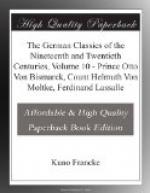As is the case with all Turkish cities, the beautiful picture vanishes the moment you enter Brussa. The smallest German town surpasses Constantinople, Adrianople, or Brussa in the charm of its buildings and still more in comfort. Only the mosques and the Hanns, or caravansaries, the fountains and public baths are magnificent. In the earlier times of the Ottoman monarchy no ruler was permitted to build a mosque before he had won a battle against the infidels. The mosques in Brussa are smaller and less beautiful than those which were built later, but they possess the added interest of historical memories. There you find such names as Orchan, Suliman, Murad, in short, all the heroes of the victorious period of Islam.
The mosque of Bajasid attracted me most because of its excellent architecture. Bajasid is the man whom the Turks call Ilderim, or the Lightning. The monument of the mighty conqueror, who himself was conquered and died in a cage according to the legend, stands alone in the shadow of mighty cypress trees. The largest of the mosques used to be a Christian cathedral. It is lighted from above, the middle vault having been left open. The beautiful Asiatic starry sky itself has become its vault. The opening is covered with a wire screen, and below it in a wide basin a fountain is playing.
I will not say that even the largest mosques, the Sultan Selim, for instance, in Adrianople, or Sulamanich in Constantinople, make the same impression or inspire the same reverence as St. Stephan’s in Vienna, or the cathedrals of Freiburg and Strassburg. But every mosque, even the smallest, is beautiful. There is nothing more picturesque than the semi-circular, lead-covered domes and the slender, white minarets rising above the mighty planes and cypresses. When the Ottomans conquered the provinces of the Eastern Roman Empire they preserved the Greek Church architecture, but they added the minarets, which are of Arabian origin.
[Illustration: COUNT MOLTKE]
The Hanns are the only stone dwelling-houses to be found. They are built in the shape of rectangles with an open court. Here, at least in the larger ones, you will find a mosque, a fountain, a small kiosk for noble travelers, and a few mulberry trees or plane trees. All about the court there is a colonnade with pointed arches; and, beyond that, rows of cells, each one with its individual vault. A mattress of straw is the only furniture for the traveler, who finds neither service nor food in these Hanns.
We dined in thoroughly Turkish fashion at the Kiebabtshi. After our hands had been washed we sat down, not at but on the table, where my legs were terribly in the way. Then the Kiebab, or small piece of mutton, broiled on the spit and rolled in dough, was served on a wooden platter. It is very good and tasty. It was followed by salted olives, which are wonderful, by the helva, i. e., the favorite sweet dish, and by a bowl of sherbet. This consists of water poured over grapes and thoroughly iced. The whole dinner for two hearty eaters cost one hundred and twenty paras, or five shillings.




